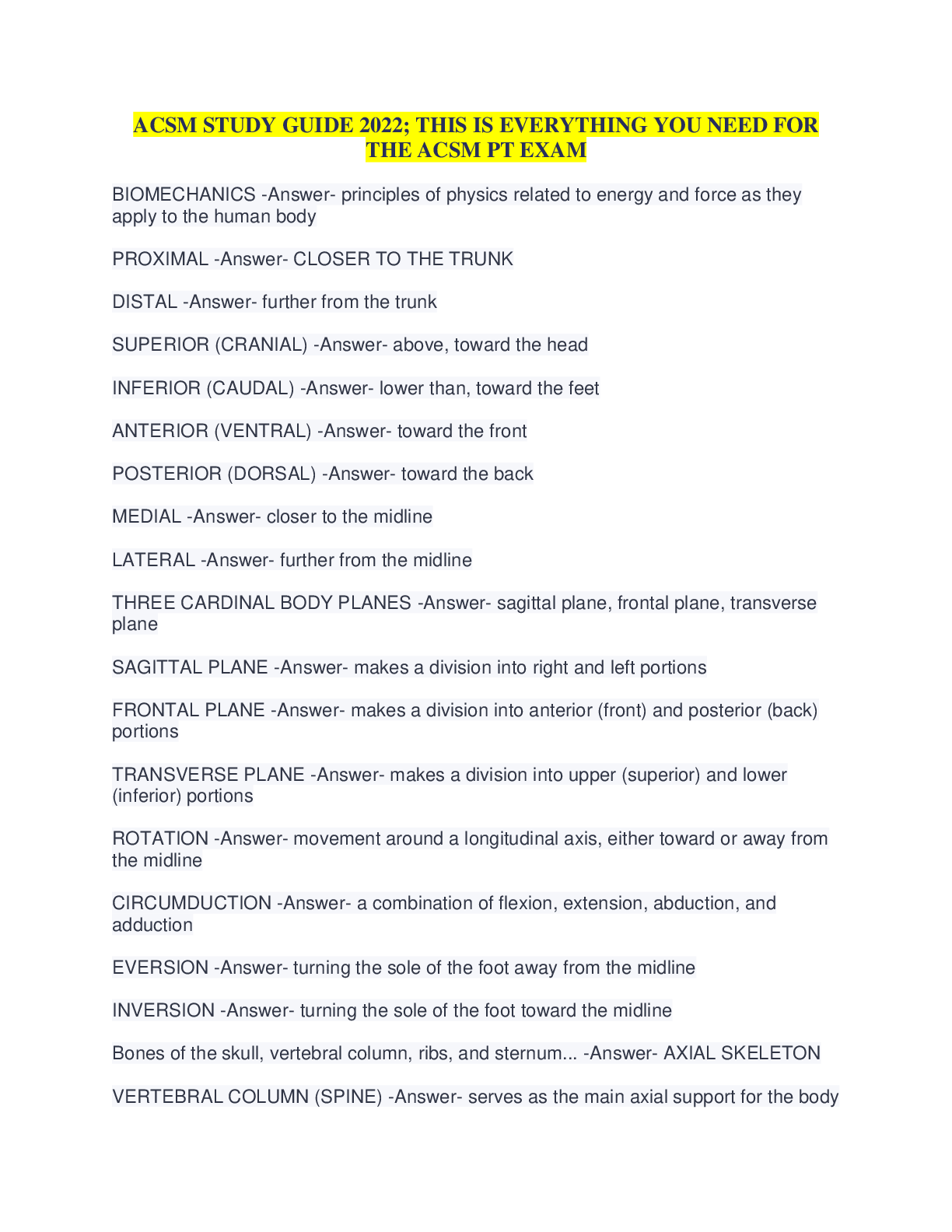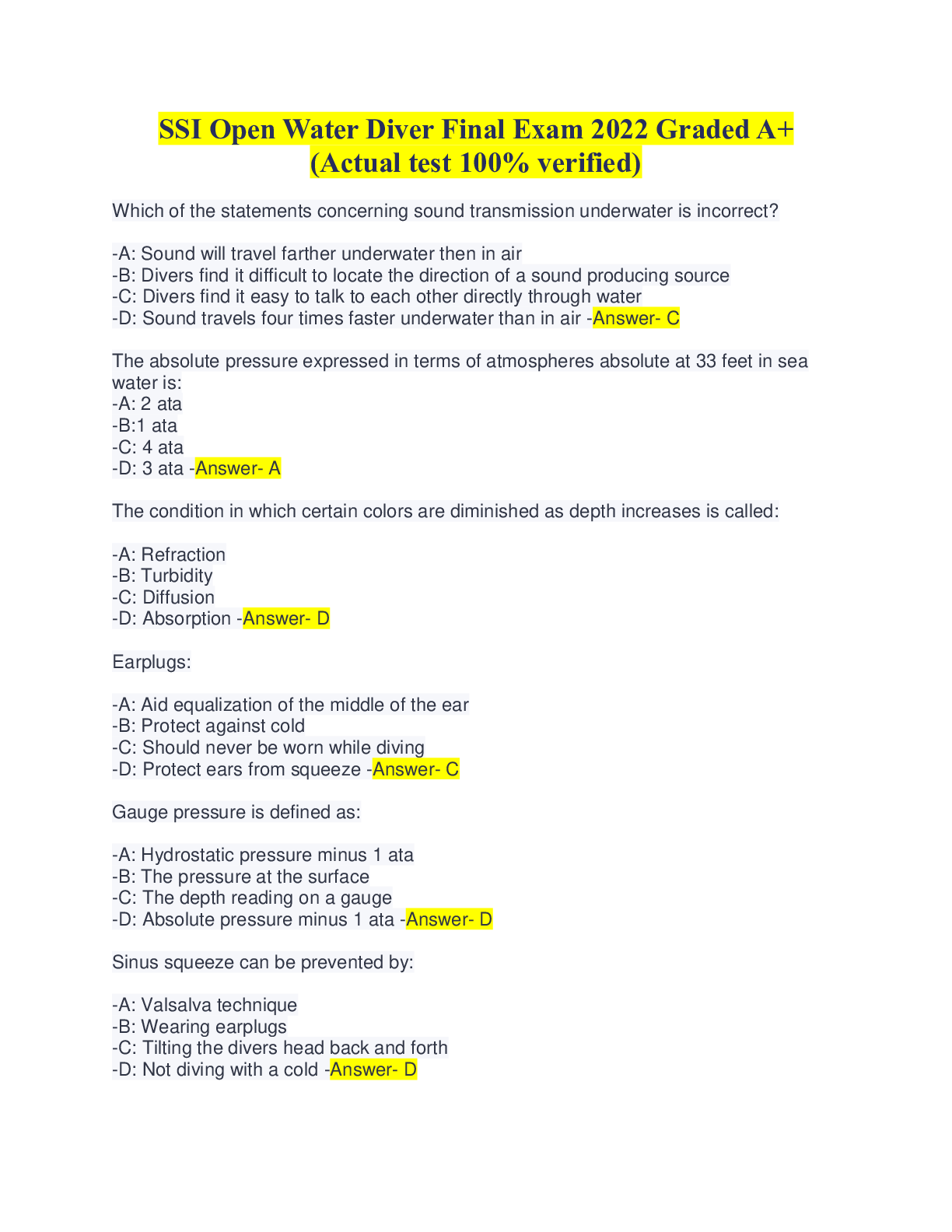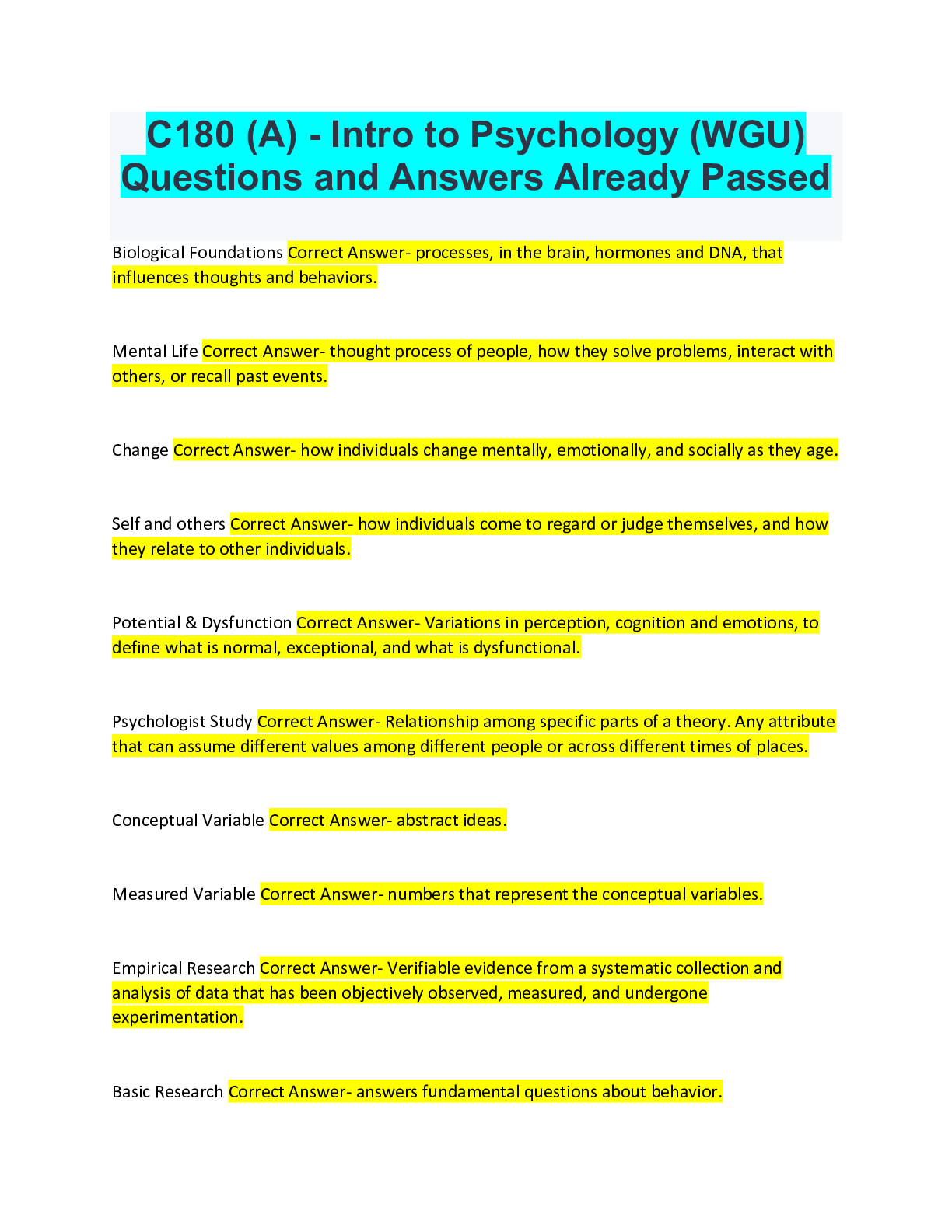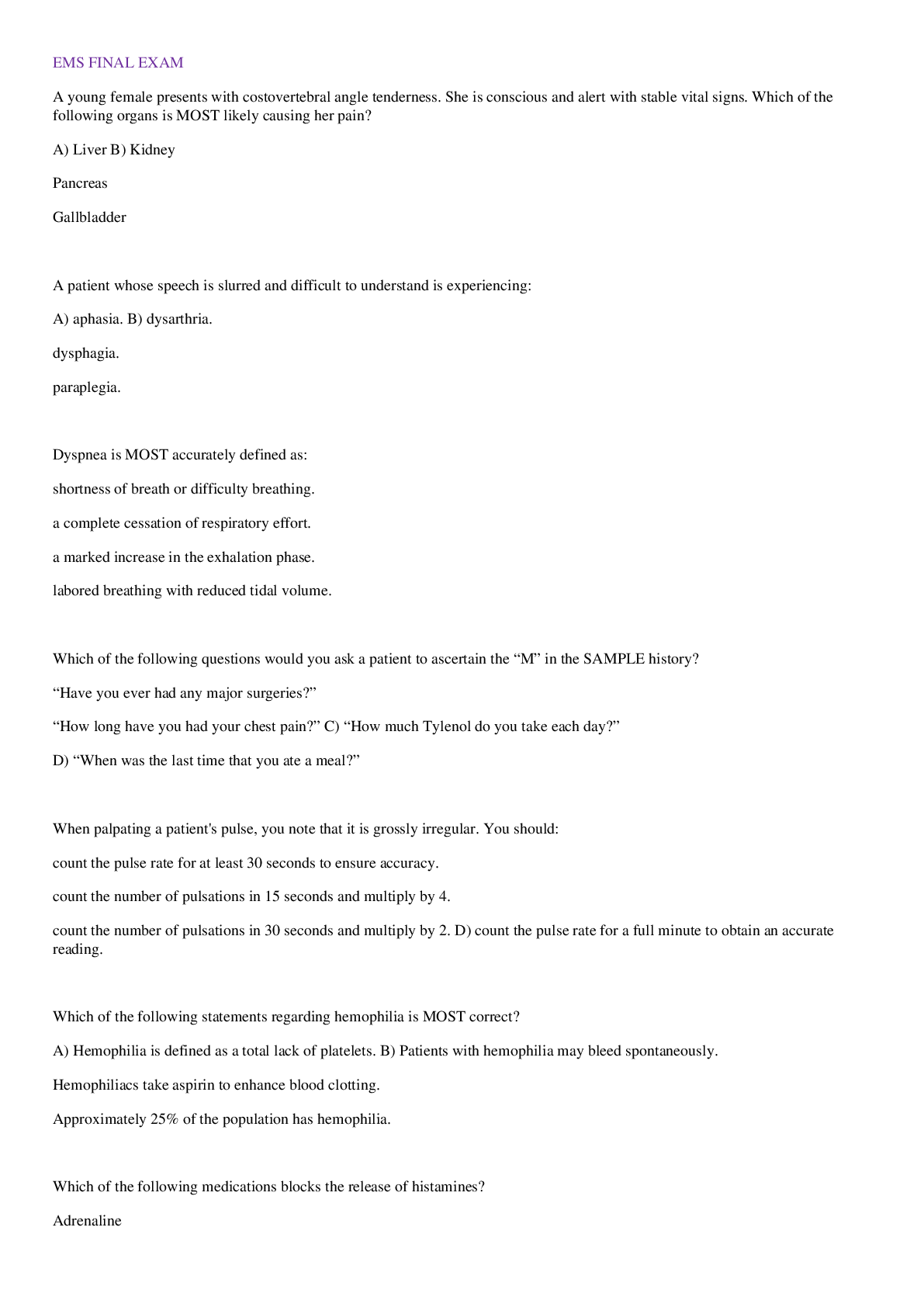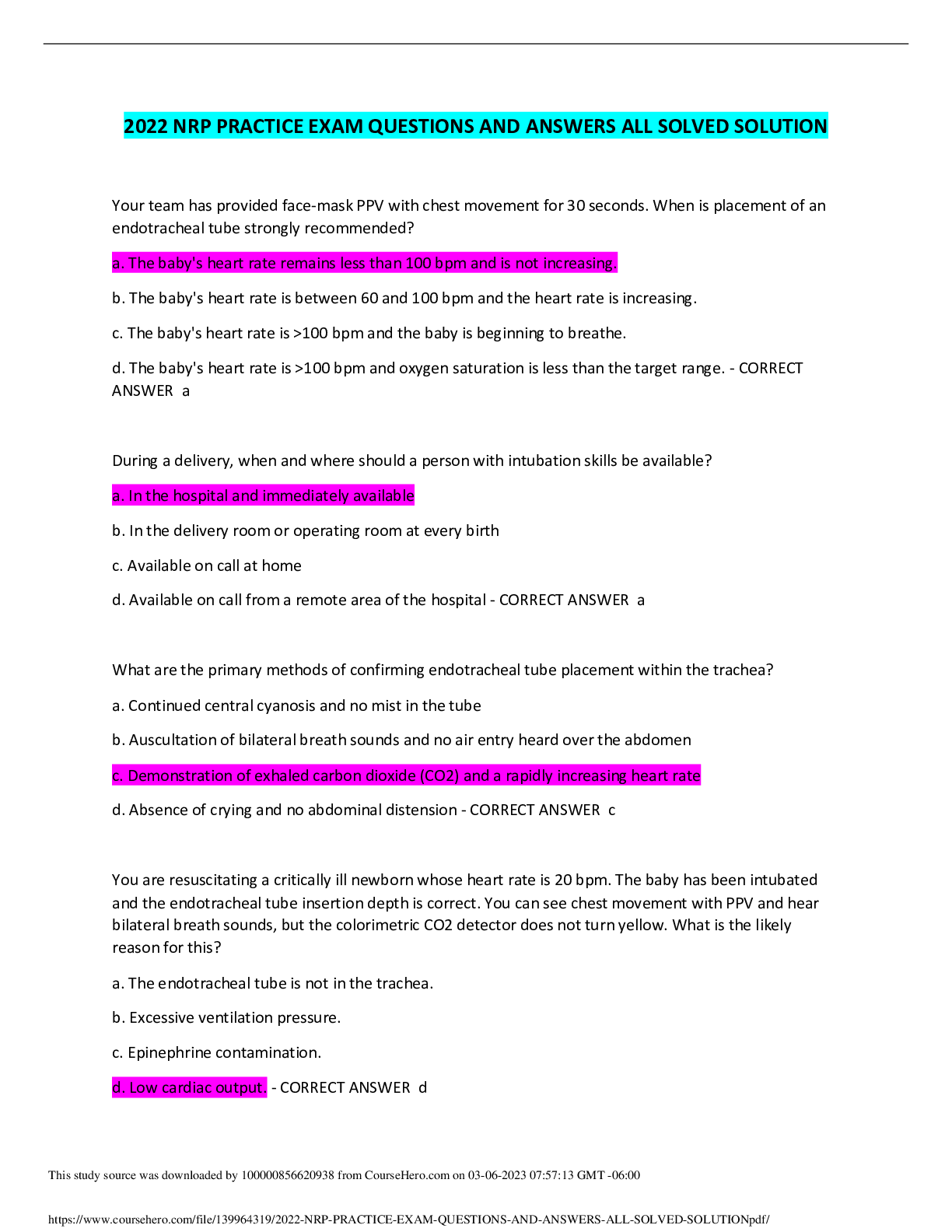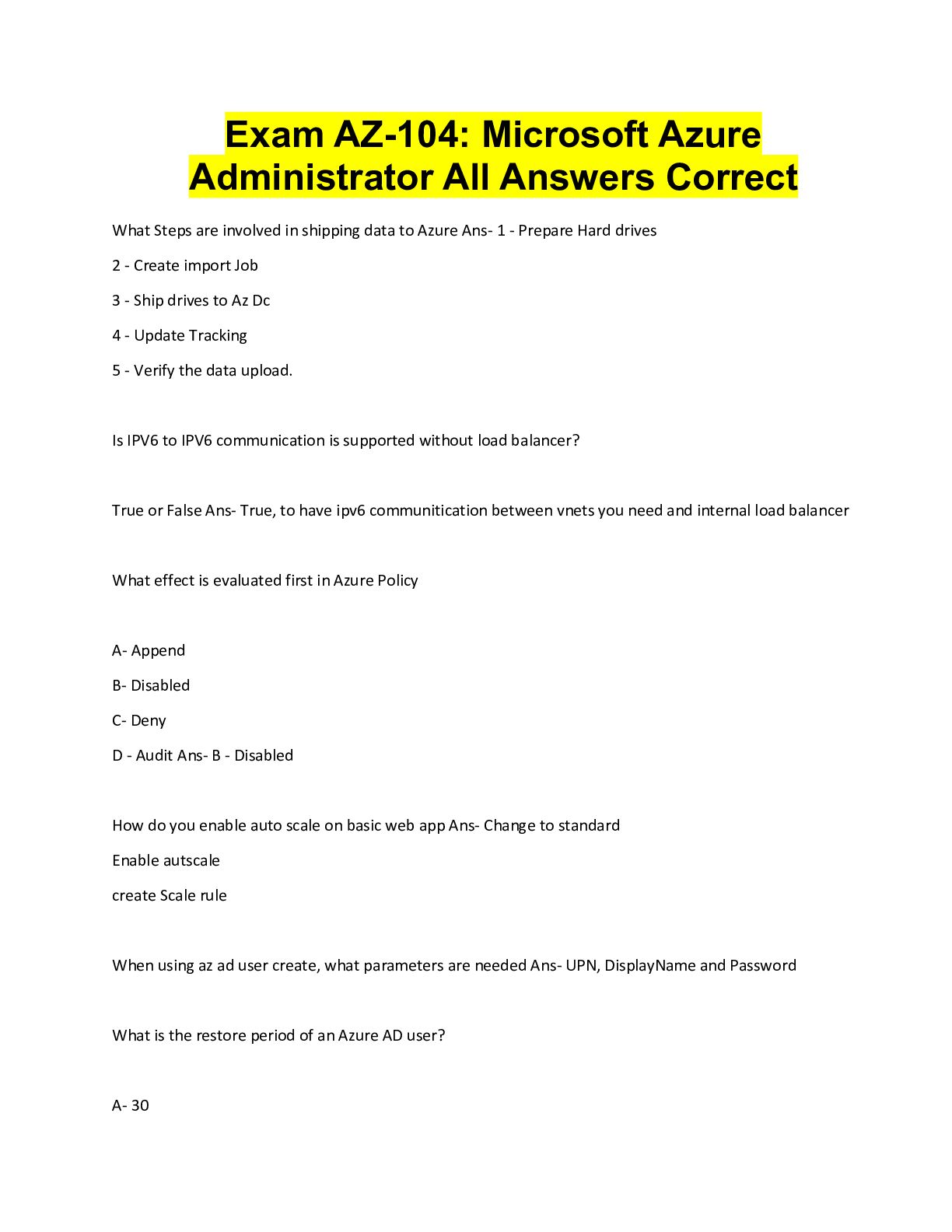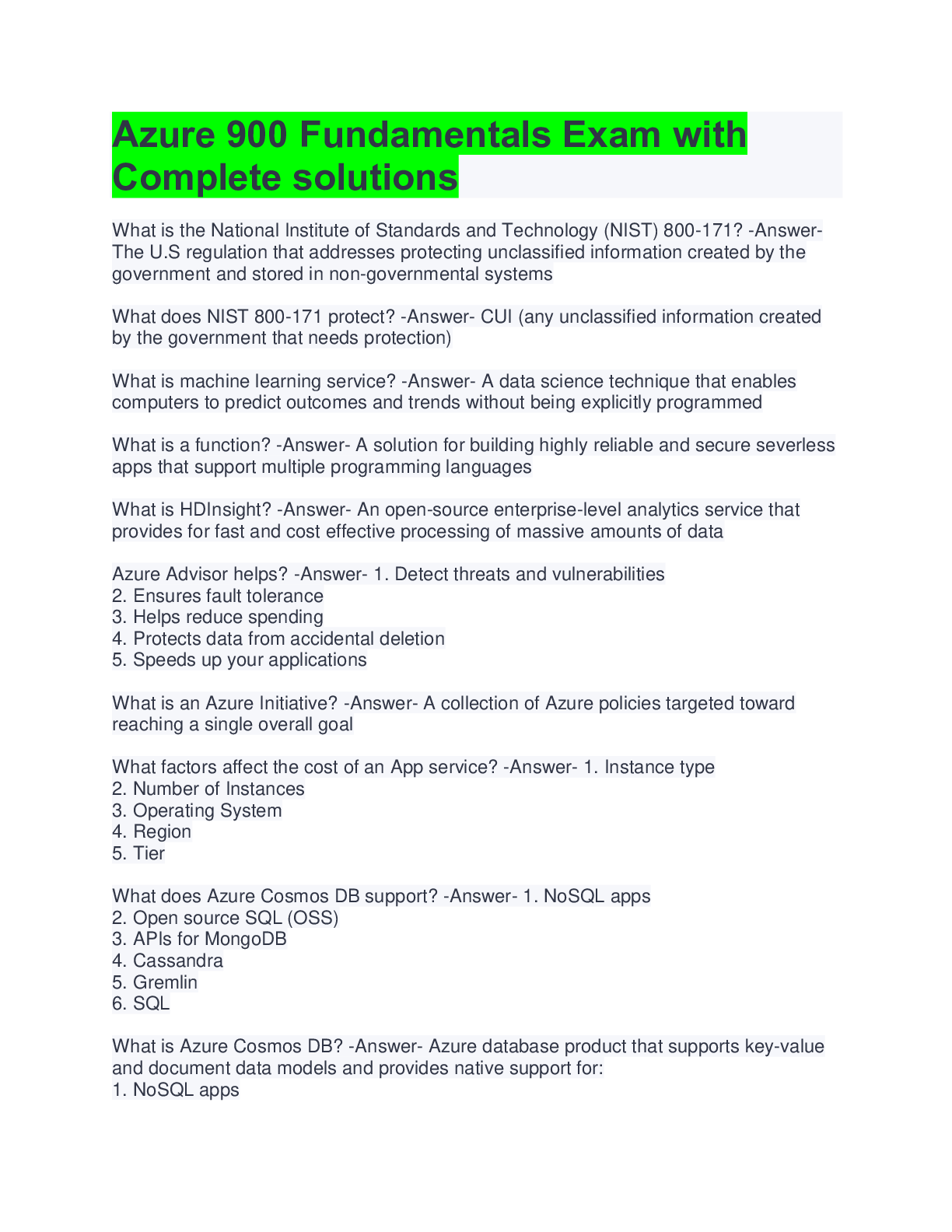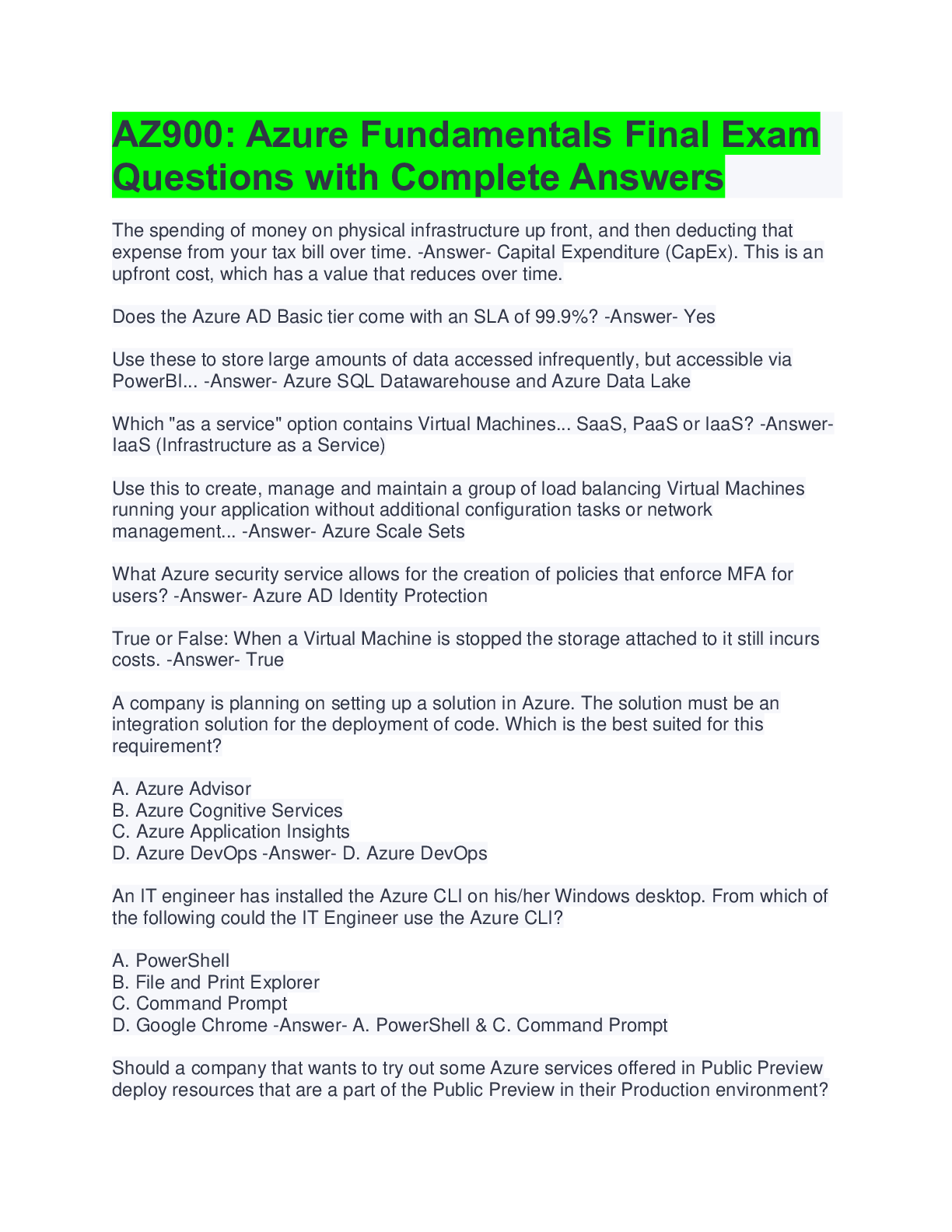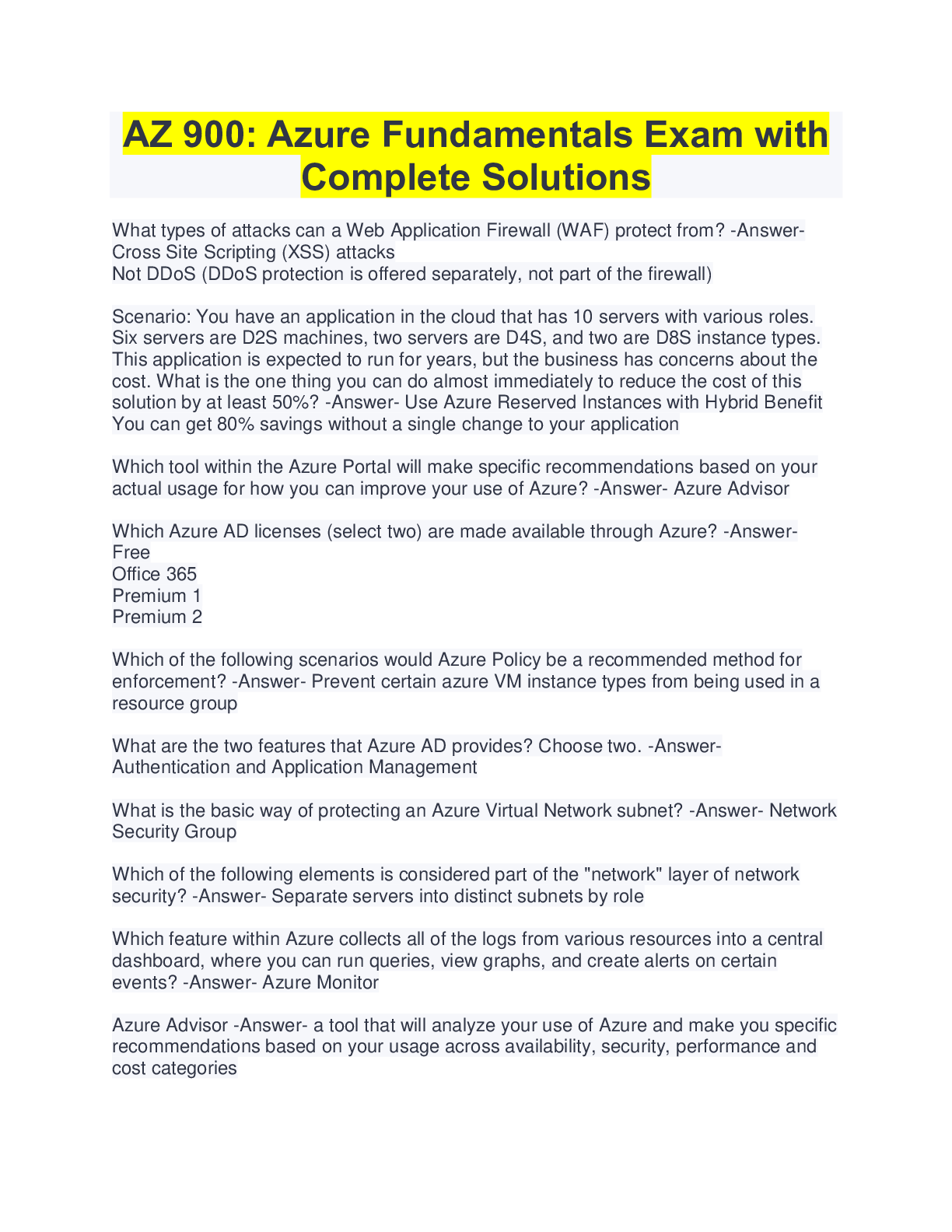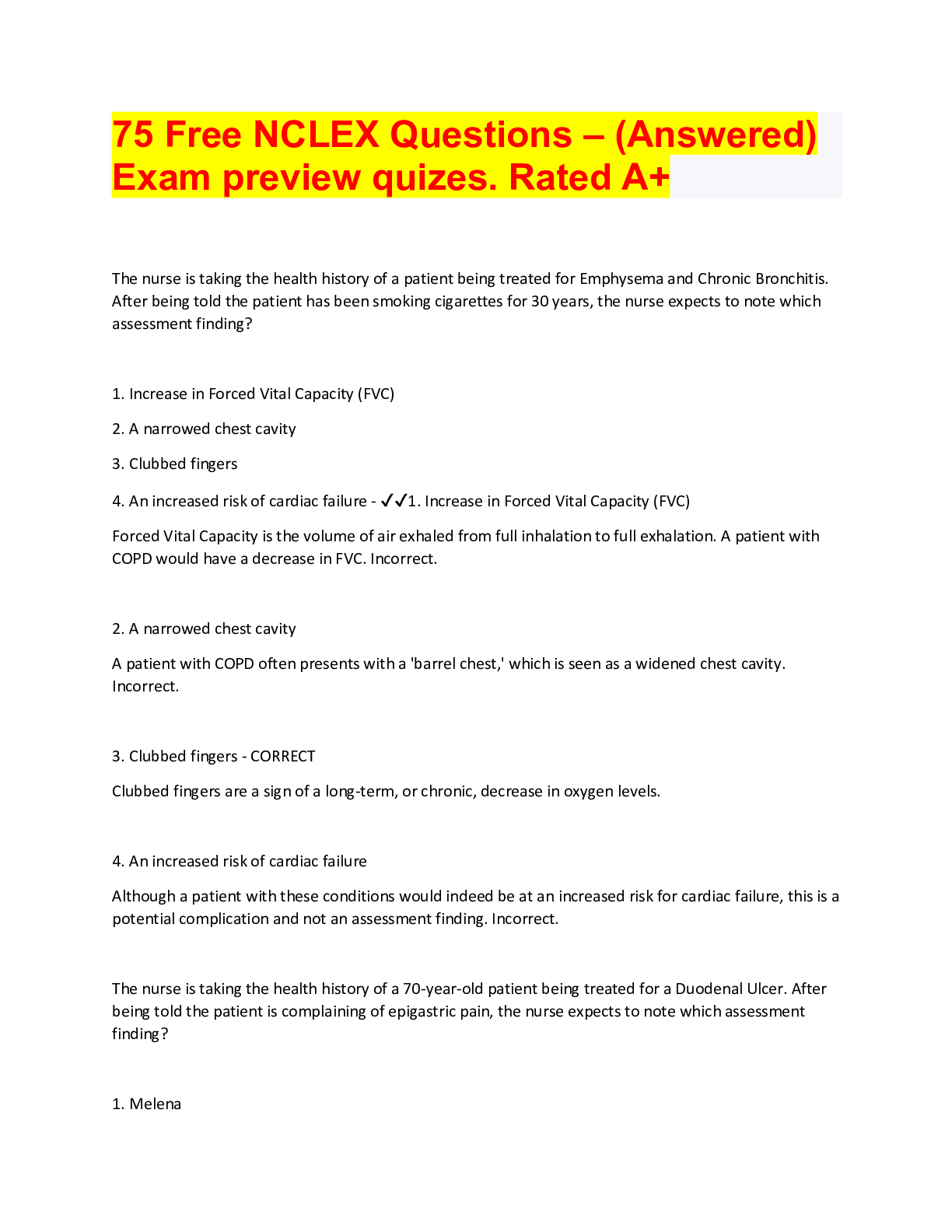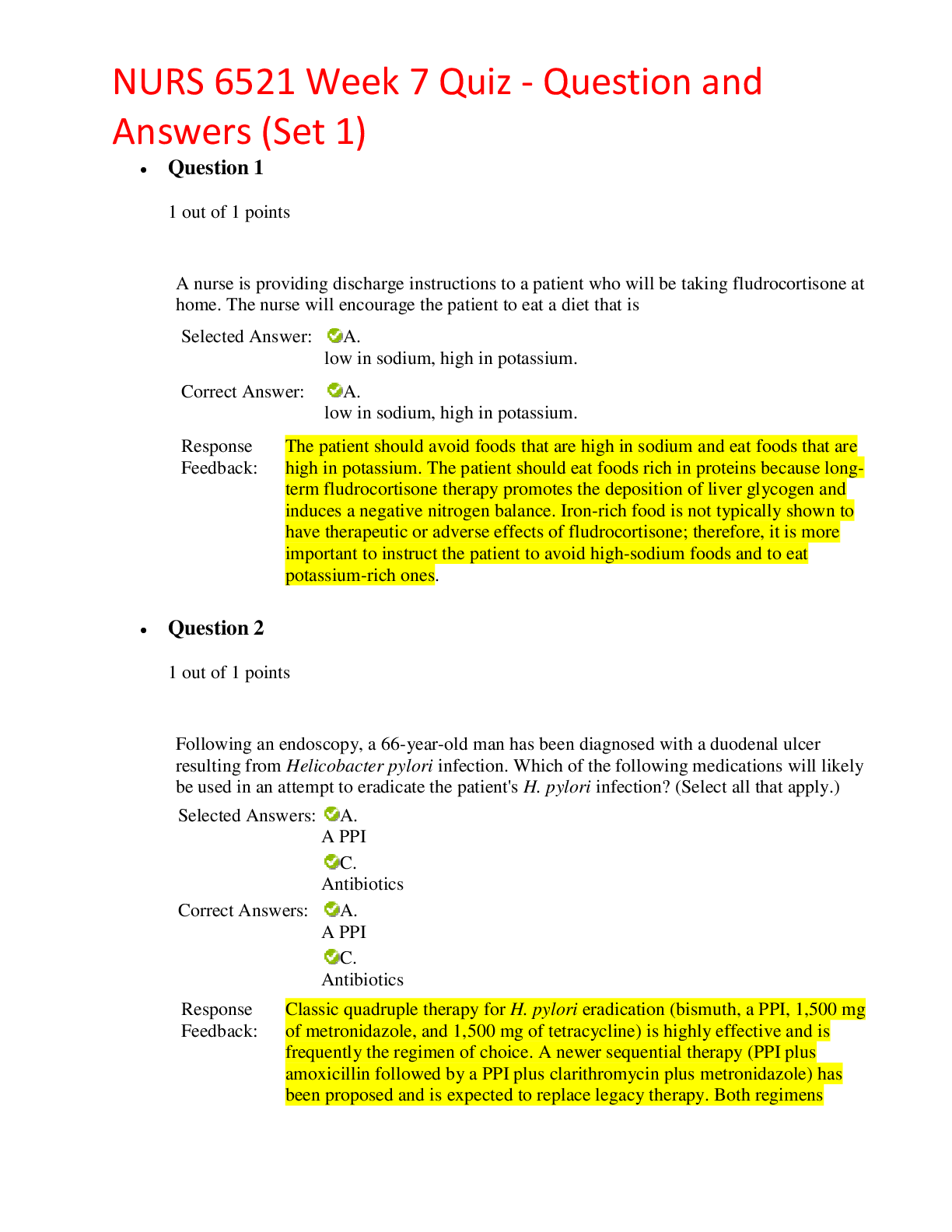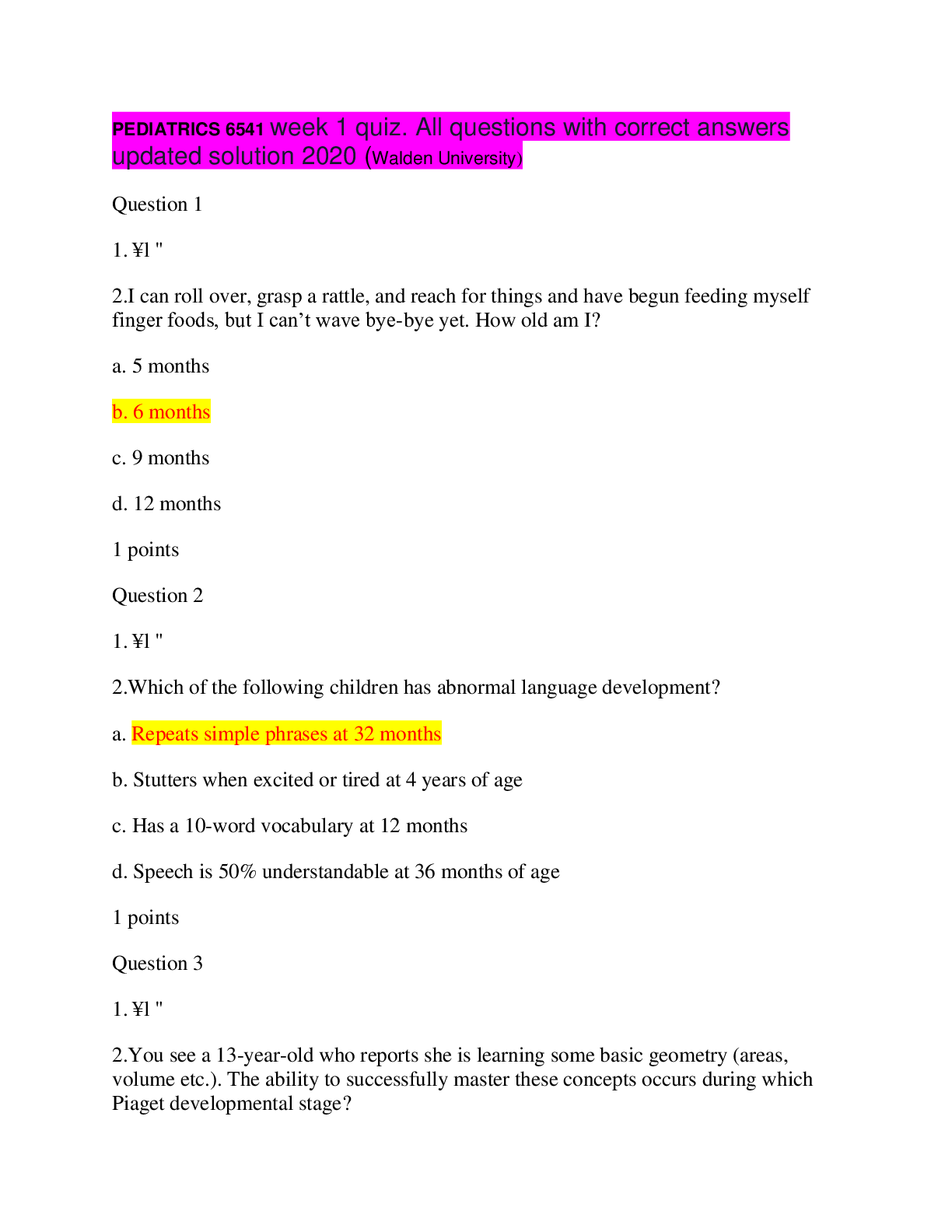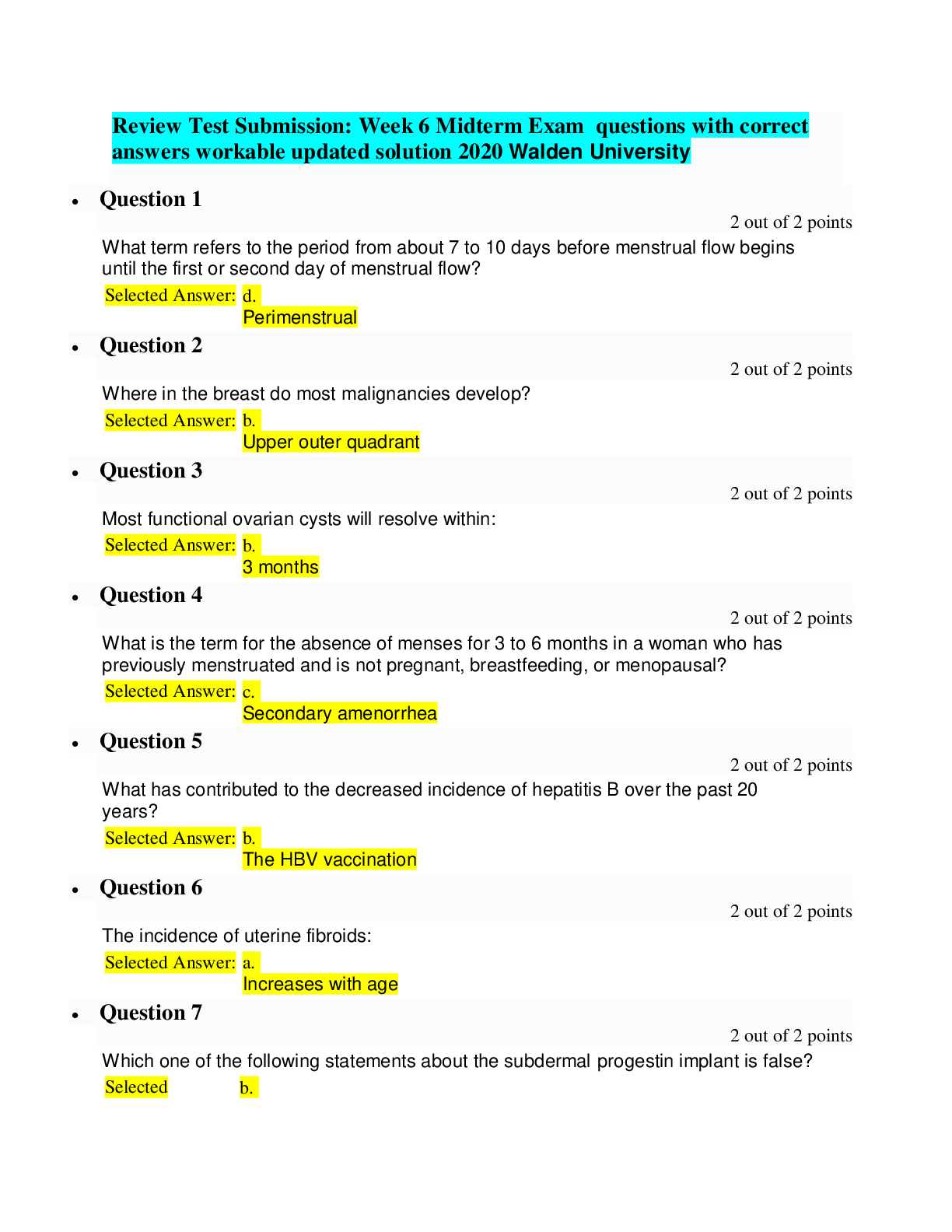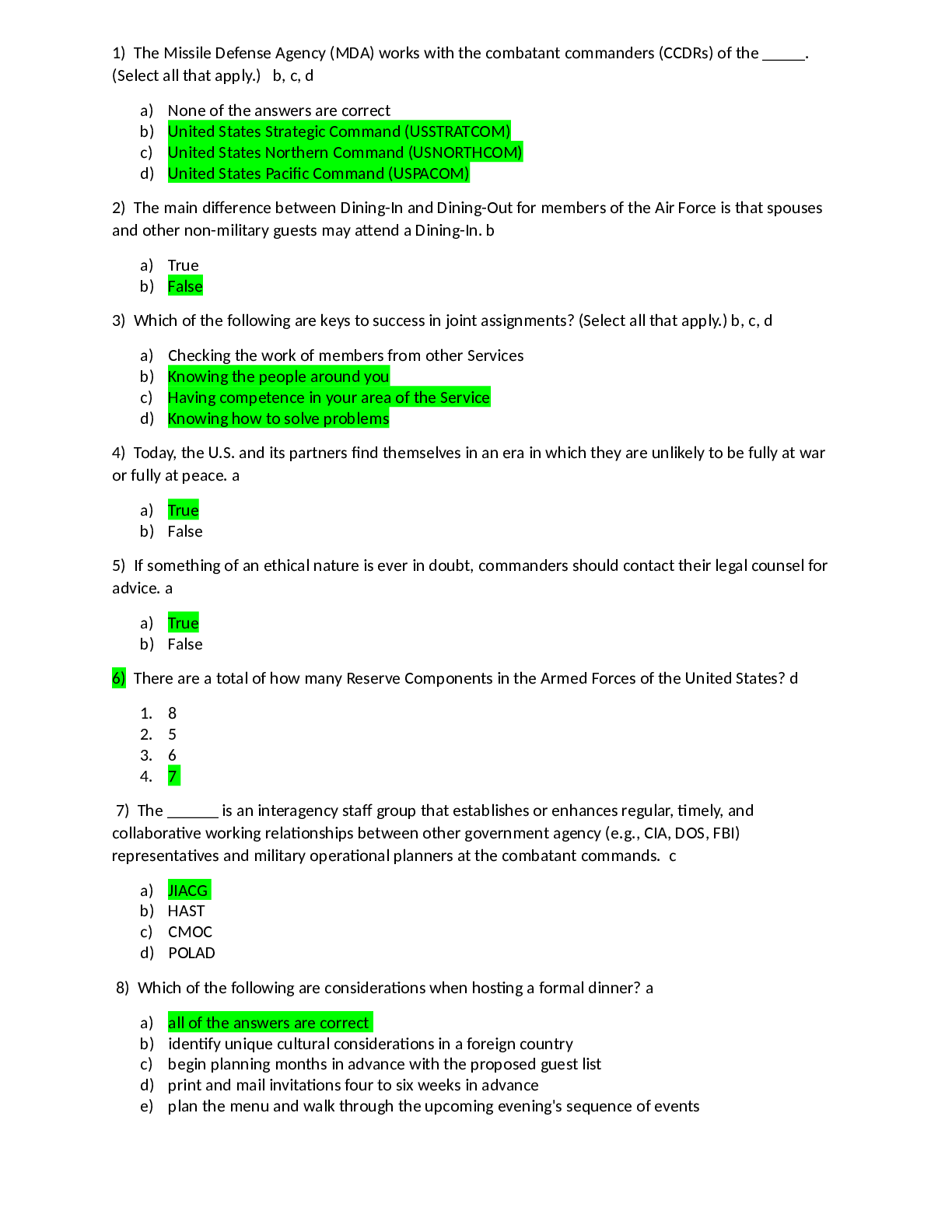Medical Studies > QUESTIONS & ANSWERS > ACSM CPT Exam Review Questions with Correct Answers (All)
ACSM CPT Exam Review Questions with Correct Answers
Document Content and Description Below
ACSM CPT Exam Review Questions with Correct Answers What is the function of the tricuspid valve? A. It acts as a pacemaker. B. To pump blood through the heart. C. Prevents backflow of blood to t... he left atrium. D. Prevents backflow of blood to the right atrium. - Answer: D What is the fundamental unit of muscle contraction? A. Myofibril B. Sarcomere C. Myosin D. Sarcolemma - Answer: B Which chamber of the heart is responsible for pumping oxygenated blood to the body? A. Right ventricle B. Left ventricle C. Right atrium D. Left atrium - Answer: B What is the natural curve in the lumbar region of the spine? A. Kyphotic curve B. Scoliotic curve C. Lordotic curve D. Myotic curve - Answer: C Adenosine triphosphate production via "anaerobic" glycolysis is associated with the significant formation of what by-product? A. Pyruvic Acid B. Phosphoric Acid C. Citric Acid D. Lactic Acid - Answer: D The changes in muscle size associated with long-term resistance training is most likely due to increases in _____. A. muscle fiber cross-sectional diameter. B. muscle fiber number. C. connective tissue thickness. D. hydration state of the muscle. - Answer: A Downhill walking/jogging/running is characterized by eccentric activation of which of the following muscle groups? A. Hamstrings B. Gastrocnemius C. Brachioradialis D. Quadriceps femoris - Answer: D What is the typical resting blood pressure response to long term aerobic exercise in a hypertensive individual? A. Both systolic and diastolic pressures will increase. B. Both systolic and diastolic pressures will decrease. C. Systolic will increase, while diastolic will remain unchanged. D. Systolic will decrease, while diastolic will remain unchanged. - Answer: B How does heart rate increase in relation to work rate and oxygen uptake during dynamic exercise? How does heart rate increase in relation to work rate and oxygen uptake during dynamic exercise? A. Exponentially B. Linearly C. Curvilinearly D. Inversely - Answer: B Which cardiovascular training approach, if repeated frequently, is most likely going to lead to overtraining? A. One intensive day followed by three easy days. B. One long day followed by three shorter duration days. C. Two consecutive intensive days, followed by one easy day. - Answer: C What feature is unique to skeletal muscle as compared to cardiac muscle? A. Absence of striations B. Presence of branching C. Requires nervous system stimulation D. Presence of intercalated disks - Answer: C What is the correct path of blood flow through the chambers of the heart? A. Left ventricle; left atrium; right atrium; right ventricle. B. Right ventricle; right atrium; left atrium; left ventricle. C. Left atrium; right atrium; left ventricle; right ventricle. D. Right atrium; right ventricle; left atrium; left ventricle. - Answer: D What respiratory muscles can cause forceful expiration? A. External intercostals B. Pectoralis minor C. Sternocleidomastoid D. Internal intercostals - Answer: D Which of the following occurs when walking or running up an incline? A. Greater flexibility of the soleus B. Lesser force of action from the gluteus maximus C. Lesser force of action of the knee extensors D. Lesser flexibility of the plantar flexors - Answer: A What two muscles, along with the supraspinatus and infraspinatus, make up the rotator cuff? A. Teres minor and scalenus B. Teres minor and subscapularis C. Teres major and scalenus D. Teres major and subscapularis - Answer: B What muscle action will most likely induce delayed onset muscle soreness? A. Concentric B. Eccentric C. Isometric D. Isotonic - Answer: B What occurs to a muscle during the eccentric movement phase of an exercise? A. Shortens while contracting B. Shortens while relaxing C. Lengthens while relaxing D. Lengthens while contracting - Answer: D What is the primary muscle group involved in trunk flexion while standing during the eccentric phase of the movement? A. Iliopsoas B. Rectus Abdominis C. Erector Spinae D. Biceps Femoris - Answer: C What muscle extends the forearm? A. Supinator teres B. Pronator teres C. Biceps brachii D. Triceps brachii - Answer: D What is the term used to describe the body's ability to utilize oxygen during exercise? A. Lactate threshold B. Anaerobic threshold C. Anaerobic capacity D. Oxygen consumption - Answer: D Which of the following is also known as the Trunk Flexion Test? A. Sit-and-reach test. B. Curl-up test for muscular endurance. C. Sit-up test for muscular endurance. D. Any test that requires clients to touch their toes. - Answer: A What is the order of stretching techniques from lowest risk of injury to highest risk of injury? A. Ballistic; slow static; proprioceptive neuromuscular facilitation. B. Slow static; ballistic; proprioceptive neuromuscular facilitation. C. Proprioceptive neuromuscular facilitation; ballistic; slow static. D. Slow static; proprioceptive neuromuscular facilitation; ballistic. - Answer: D Which of the following joints has the greatest range of motion, and involves the greatest number of movements? A. Knee joint B. Shoulder joint C. Hip joint D. Ankle joint - Answer: B What change may occur between heart rate and blood pressure as a result of chronic exercise? A. Resting heart rate and resting blood pressure are reduced. B. Resting heart rate reduces, but resting blood pressure stays the same. C. Maximal heart rate increases but maximal blood pressure stays the same. D. Resting heart rate and resting blood pressure stay the same, but maximal heart rate and maximal blood pressure are reduced. - Answer: A Which of the following is a result of chronic aerobic training? A. Increased lipid production. B. Decreased plasma triglyceride levels. C. Decreased high-density lipoprotein (HDL) levels. D. Increased low-density lipoprotein (LDL) levels. - Answer: B Mitral valve prolapse is a condition which primarily affects the . A. Sino-atrial node. B. Bicuspid valve. C. Tricuspid valve. D. Descending aorta. - Answer: B What action is involved in the concentric phase of the biceps curl? A. Flexion at the elbow. B. Extension at the elbow. C. Pronation of the forearm. D. Supination of the forearm. - Answer: A Cardiac output is a product of heart rate multiplied by ___________. A. peripheral resistance. B. blood pressure. C. blood volume. D. stroke volume. - Answer: D Which of the following best describes the symptoms that occur at 24-48 hours after a single bout of intensive exercise? A. Delayed onset muscle strain. B. Acute onset muscle strain. C. Delayed onset muscle soreness. D. Acute onset muscle soreness. - Answer: C Which principle of training best describes a previously active client, who has been ill and bedridden for a prolonged period of time? A. Overload B. Specificity C. Reversibility D. Progression - Answer: C If you are palpating the thumb side of the forearm in the wrist area, what pulse are you checking? A. Humeral B. Ulnar C. Brachial D. Radial - Answer: D What is the correct order of the regions of the spinal column, from superior to inferior? A. Cervical, lumbar, thoracic, sacral and coccyx. B. Coccyx, sacral, lumbar, thoracic, and cervical. C. Cervical, thoracic, lumbar, coccyx, and sacral. D. Cervical, thoracic, lumbar,sacral, and coccyx. - Answer: D Which muscle is an antagonist of the hamstrings? A. Gastrocnemius B. Iliopsoas C. Gracilis D. Sartorius - Answer: B Which of the following physiological changes does NOT occur when a client improves aerobic capacity? A. The muscles will be able to extract more oxygen from the blood. B. Total lung volume will increase in proportion to the total accumulated time of high-intensity exercise. C. The oxygen carrying capacity of the blood will increase. D. The amount of air the lungs can take in will increase because of increases in the rate and depth of breathing. - Answer: B As the intensity of dynamic exercise increases, which of the following sets of responses occurs? A. Heart rate, systolic blood pressure, and diastolic blood pressure increase. B. Heart rate and systolic blood pressure increase, diastolic pressure remains unchanged. C. Heart rate and systolic blood pressure increase, stroke volume and cardiac output remain the same. D. Stroke volume decreases, heart rate and cardiac output increase. - Answer: B [Show More]
Last updated: 2 years ago
Preview 1 out of 37 pages

Buy this document to get the full access instantly
Instant Download Access after purchase
Buy NowInstant download
We Accept:

Reviews( 0 )
$9.00
Can't find what you want? Try our AI powered Search
Document information
Connected school, study & course
About the document
Uploaded On
Sep 13, 2022
Number of pages
37
Written in
Additional information
This document has been written for:
Uploaded
Sep 13, 2022
Downloads
0
Views
248
